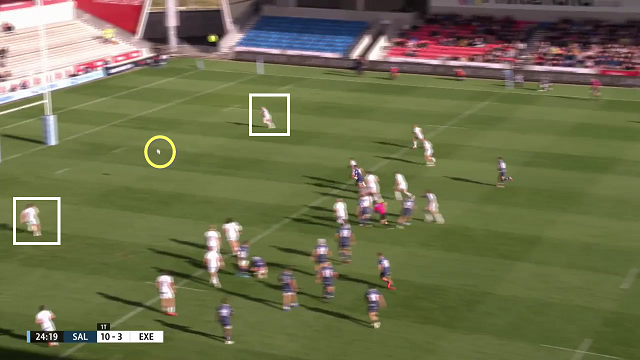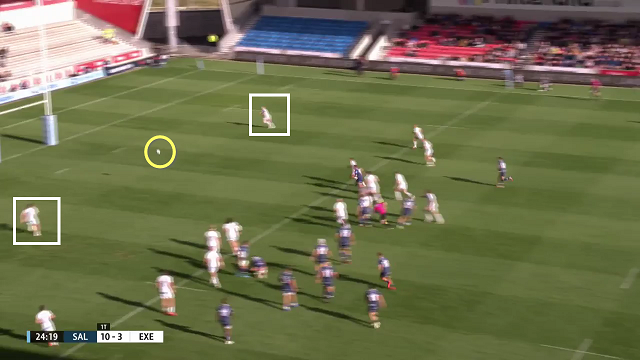Why kicking for the posts has taken on a new meaning
The new global law trials are beginning to filter slowly into the field of awareness of professional teams across the world. On Saturday, a raking 50/22 kick by replacement full-back Frans Steyn helped keep the Springboks in charge of the nail-biting final quarter of their game against the All Blacks.
The ability to kick long from the back provided a noticeable territorial advantage to South Africa after Steyn had come on for the starting number 15 Willie le Roux.
Over in the U.K, and particularly with the beginning of the new domestic league season in England, some experiments with the other trial law regarding goal-line drop-outs have been in evidence. This law has travelled under the radar, probably unjustifiably, in comparison to the higher public profile of the 50/22.
Here is a reminder of the wording of the new trial law:
Law 12 (restart kicks section)
Play is restarted with a goal line drop-out when:
i. The ball is played or taken into in-goal by an attacking player and is held up by an opponent.
ii. An attacking kick, other than a kick-off, restart kick following a score, drop goal or penalty attempt, is grounded, or made dead by the defending team in their own in-goal.
iii. An attacking player knocks on in the opponents’ in-goal.
Law 21.16 -Ball held up in-goal
When a player carrying the ball is held up in the in-goal so that the player cannot ground or play the ball, the ball is dead. Play restarts with a goal line drop-out.
World Rugby’s stated aim is, “to encourage variety in attacking play close to the goal line and to increase ball in play time by replacing a scrum with a kick that must be taken without delay. An opportunity for counter attack is also created.”
The most interesting aspect of the law for the attacking side is the effective extension of the field in play in section 12.ii. An attacking kick can now go dead in-goal and still provide a very ‘live’ platform for counter-attack from the ensuing goal-line drop-out. The pressure stays very firmly on the defensive side.
In England, this has already encouraged some experimentation with short kicking in the direction of the goal-posts. This basic example comes from last weekend’s Gallagher Premiership match between Sale and Exeter:
In the event the threat is defused quite easily, but the Exeter Chiefs still have to drop out from their own goal-line, with Sale getting the ball back in excellent position near the 22m line.
The reason that the kick goes straight down the middle of the field can be viewed in a screenshot of the defensive set-up:

At positions just outside their own 22, most defences will set up with two defenders spread to either side of the backfield zone, so there is space right down the middle between them.
Now let’s move on to a more successful attempt from the game between Leicester and Saracens:
The space is still ‘straight down the pipe’ in between the two backfield book-ends, but an additional bonus comes into play: the difficulty for the defenders of navigating around the posts – or unpredictable deflections off them. There are three Leicester chasers in pursuit, and the Saracens number 11 finds the left post blocking his attempts to get to the ball in defence.
‘Patient Zero’ in this context probably occurred in the first Rugby Championship encounter between Australia and Argentina:
Both field position (with the attack in midfield just outside the 22 line) and the defensive alignment (with two backfield defenders spread to either edge) is identical to the Leicester and Sale games.
The added subtlety is that the Wallaby number 10 Quade Cooper takes the ball right to the line before delivering a zone-splitting kick, and that has the effect of pulling the primary chaser (Australia number 13 Len Ikitau) closer to the ball for the reclaim on the ground. His fellow centre Samu Kerevi is able to pick up the ball and score on the following play.
Summary
The new rules around goal-line dropouts may already be having some subtle, but far-reaching effects. The law variation has effectively increased the size of the ‘live’ field to include the in-goal area for the attack. There is the potential for splitting the backfield and using the posts either for advantageous deflections or to create problems for defenders converging on the ball; or at worst, getting the ball back in excellent field position just outside the 22 if the ball is touched down by the D. ‘Kicking for the poles’ will have a meaning beyond taking three points off the tee from now on, and it may never be quite the same again.












.jpg)

.jpg)







